Revealing Mithras’ Color with the ICVBC Mobile Lab in the Museum
Abstract
:1. Introduction
2. Materials and Methods
Experimental
3. Results and Discussion
4. Conclusions
Author Contributions
Funding
Conflicts of Interest
References
- Lissi-Caronna, E. IL Mitreo dei Castra Peregrinorum (S. Stefano Rotondo); Brill Publisher: Leiden, UK, 1986; ISBN 9789004296565. [Google Scholar]
- Brandenburg, H. Santo Stefano Rotondo sul Celio, l’ultimo edificio monumentale di Roma fra antichità e medioevo. In Roma Dall’antichità al Medioevo, 2 vol. Contesti tardoantichi e Altomedievali; Paroli, L., Vendittelli, L., Eds.; Mondadori Electa: Milan, Italy, 2004; pp. 480–505. [Google Scholar]
- Di Giacomo, G. Una statua di Mitra che nasce dalla roccia. In Catalogo del Museo Nazionale Romano—Terme di Diocleziano; Friggeri, R., Granino, M.G., Gregori, G.L., Eds.; Electa: Milano, Italy, 2012; pp. 642–643. ISBN 88-370-8934-1. [Google Scholar]
- Borgognoni, C. Un rilievo mitraico. In Catalogo del Museo Nazionale Romano—Terme di Diocleziano; Friggeri, R., Granino, M.G., Gregori, G.L., Eds.; Electa: Milano, Italy, 2012; pp. 647–648. ISBN 88-370-8934-1. [Google Scholar]
- Borgognoni, C.B. Un piccolo rilievo mitraico. In Catalogo del Museo Nazionale Romano—Terme di Diocleziano; Friggeri, R., Granino, M.G., Gregori, G.L., Eds.; Electa: Milano, Italy, 2012; ISBN 88-370-8934-1. [Google Scholar]
- Iannaccone, R.; Bracci, S.; Cantisani, E.; Mazzei, B. An integrated multi-methodological approach for characterizing the materials and pigments on a sarcophagus in St. Mark, Marcellian and Damasus catacombs. Appl. Phys. A 2015, 121, 1235–1242. [Google Scholar] [CrossRef]
- Liverani, P.; Bracci, S.; Iannaccone, R.; Lenzi, S.; Magrini, D.; Mazzei, B. Colours in the dark: New researches into catacombs. In Polychromy in Ancient Sculpture and Architecture; Bracci, S., Giachi, G., Liverani, P., Pallecchi, P., Paolucci, F., Eds.; Sillabe: Livorno, Italy, 2018; pp. 94–105. ISBN 978-88-8347-997-7. [Google Scholar]
- Noferi, C.; Bracci, S.; Iannaccone, R.; Lenzi, S.; Magrini, D. Consideration on Polychromy from a group of nenfro sarcophagi at the Archaeological Museum in Florence, from Gens Statlane Tomb in Tuscania (Viterbo). In Polychromy in Ancient Sculpture and Architecture; Bracci, S., Giachi, G., Liverani, P., Pallecchi, P., Paolucci, F., Eds.; Sillabe: Livorno, Italy, 2018; pp. 27–34. ISBN 978-88-8347-997-7. [Google Scholar]
- Karidas, A.G.; Brecoulaki, H.; Bourgeois, B.; Jockey, P.H. In-situX-Ray Fluorescence analysis of raw pigments and traces of polychromy on Hellenistic sculptureat the archaeological museum of Delos. In Proceedings of the 7th International Conference of ASMOSIA, Association for the Study of Marble and Other Stones in Antiquity, Thassos, Greece, 15–20 September 2003; pp. 811–829. [Google Scholar]
- Bacci, M. Fibre optics applications to works of art. Sens. Actuators 1995, 29, 190. [Google Scholar] [CrossRef]
- Bacci, M. UV-VIS-NIR, FT-IR and FORS Spectroscopies. In Modern Analytical Methods in Art and Archaeology; Ciliberto, E., Spoto, G., Eds.; Wiley: Chichester, UK, 2000; pp. 321–360. [Google Scholar]
- Bacci, M.; Fabbri, M.; Picollo, M.; Porcinai, S. Non-invasive fibre optic Fourier transform-infrared reflectance spectroscopy on painted layers. Anal. Chim. Acta 2001, 446, 15–21. [Google Scholar] [CrossRef]
- Aldrovandi, A.; Bertani, D.; Cetica, M.; Matteini, M.; Moles, A.; Poggi, P. Multispectral image processing of paintings. Stud. Conserv. 1988, 33, 154–159. [Google Scholar]
- Aldrovandi, A.; Buzzegoli, E.; Keller, A.; Kunzelman, D. Investigation of painted surfaces with a reflected UV false colour technique. In Proceedings of the 8th International Conference on Non Destructive Investigations and Micro Analysis for the Diagnostics and Conservation of the Cultural and Environmental Heritage, Lecce, Italy, 15–19 May 2005; pp. 3–18. [Google Scholar]
- Fischer, C.; Kakoulli, I. Multispectral and hyperspectral imaging technologies in conservation: Current research and potential applications. Rev. Conserv. 2006, 7, 3–16. [Google Scholar] [CrossRef]
- Costello, S.D.; Klausmeyer, P. A re-united pair: The conservation, technical study, and ethical decisions involved in exhibiting two terracotta orante statues from Canosa. Stud. Conserv. 2014, 59, 377–390. [Google Scholar] [CrossRef]
- De la Rie, E.R. Fluorescence of paint and varnish layers (part 1). Stud. Conserv. 1982, 27, 1–7. [Google Scholar]
- Hofenk de Graaff, J.H.; Roelofs, W.G.T.; van Bommel, M.R. The Colourful Past: Origins, Chemistry and Identification of Natural Dyestuffs, Archetype; Riggisberg Abegg-Stiftung: London, UK, 2004. [Google Scholar]
- Daniels, V.; Devièse, T.; Hacke, M.; Higgitt, C. Technological Insights into Madder Pigment Production in Antiquity; Technical Research Bulletin; British Museum: London, UK, 2014; pp. 13–28. [Google Scholar]
- Fostiridou, A.; Karapanagiotis, I.; Vivdenko, S.; Lampakis, D.; Mantzouris, D.; Achilara, L. Identification of pigments in hellenistic and Roman funeral figurines. Archaeometry 2016, 58, 453–464. [Google Scholar] [CrossRef]
- Kakoulli, I.; Radpour, R.; Lin, Y.; Svoboda, M.; Fischer, C. Application of forensic photography for the detection and mapping of Egyptian blue and madder lake in Hellenistic polychrome terracottas based on their photophysical properties. Dyes Pigments 2017, 136, 104–115. [Google Scholar] [CrossRef]
- Bisulca, C.; Picollo, M.; Bacci, M.; Kunzelman, D. UV-Vis-NIR Reflectance Spectroscopy of Red Lakes in Paintings. In Proceedings of the 9th International Conference on Nondestructive Testing of Art, Jerusalem, Israel, 25–30 May 2008; pp. 25–30. [Google Scholar]
- Accorsi, G.; Verri, G.; Bolognesi, M.; Armaroli, N.; Clementi, C.; Miliani, C.; Romani, A. The exceptional near infrared luminescence properties of cuprorivaite (Egyptian Blue). Chem. Commun. 2009, 23, 3392–3394. [Google Scholar] [CrossRef] [PubMed]
- Verri, G. The spatial resolved characterization of Egyptian Blue, Han Blue and Han Purple by photo-induced luminescence digital imaging. Anal. Bioanal. Chem. 2009, 394, 1011–1021. [Google Scholar] [CrossRef] [PubMed]
- Verri, G. The ‘Treu Head’: A case study in Roman sculptural polychromy. Br. Mus. Tech. Res. Bull. 2010, 4, 39–54. [Google Scholar]
- Mirti, P.; Appolonia, L.; Casoli, A.; Ferrari, R.P.; Laurenti, E.; Amisano Canesi, A.; Chiari, G. Spectrochemical and structural studies on a roman sample of Egyptian blue. Spectrochim. Acta Part A Mol. Biomol. Spectrosc. 1995, 51, 437–446. [Google Scholar] [CrossRef]
- Bourgeois, B. Thérapéia. Taking Care of Colour in Hellenistic Greece. In Transformations. Classical Sculpture in Colour; Østergaard, J.S., Nielsen, A.M., Eds.; Ny Carlsberg Glyptotekpublisher: Copenhagen, Denmark, 2014; pp. 190–207. [Google Scholar]
- Liverani, P. L’Augusto di Prima Porta. In I Colori del Bianco. Policromia Nella Scultura Antica; Casa Editrice Vaticano: Rome, Italy, 2004; pp. 235–242. [Google Scholar]
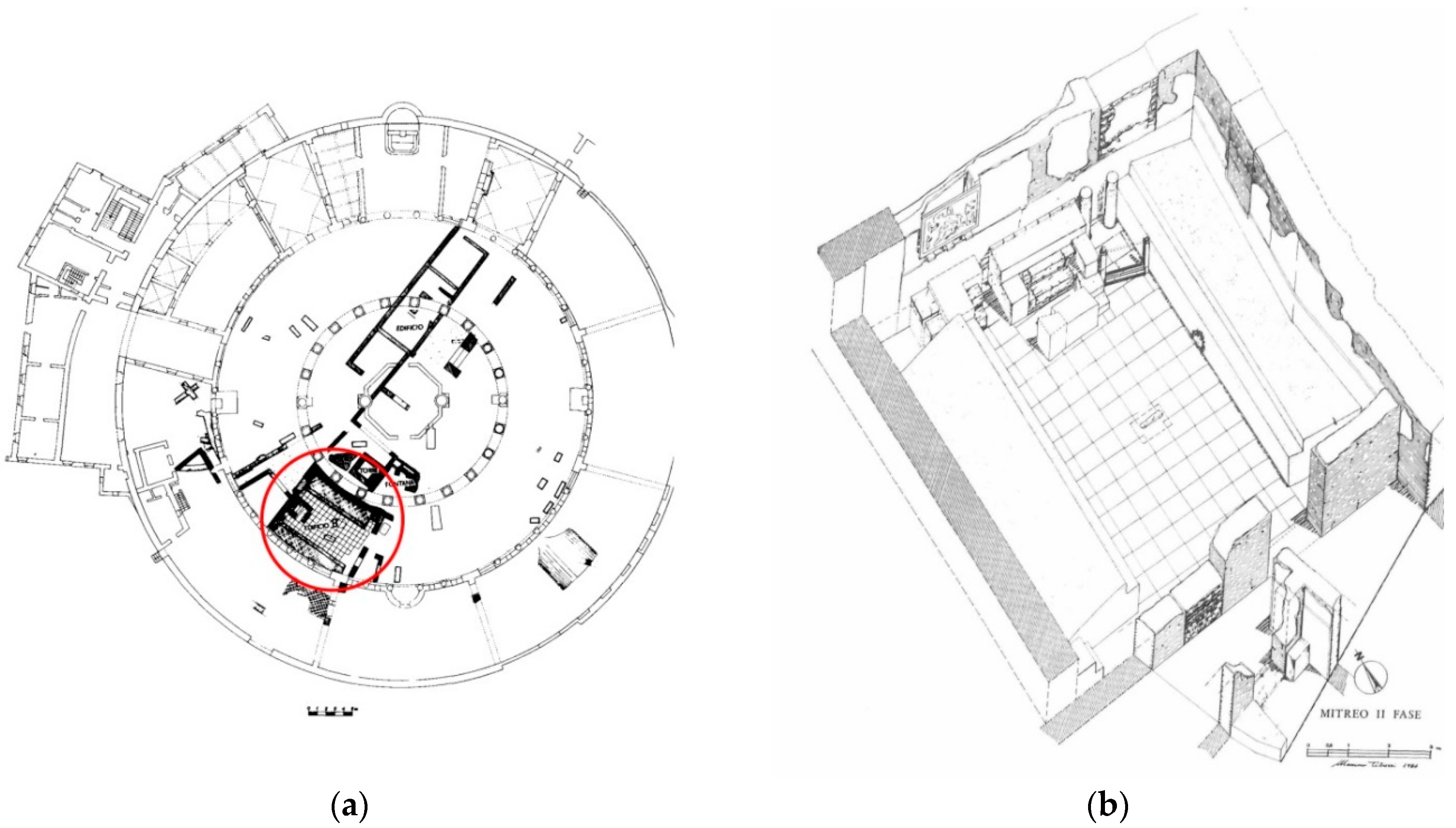
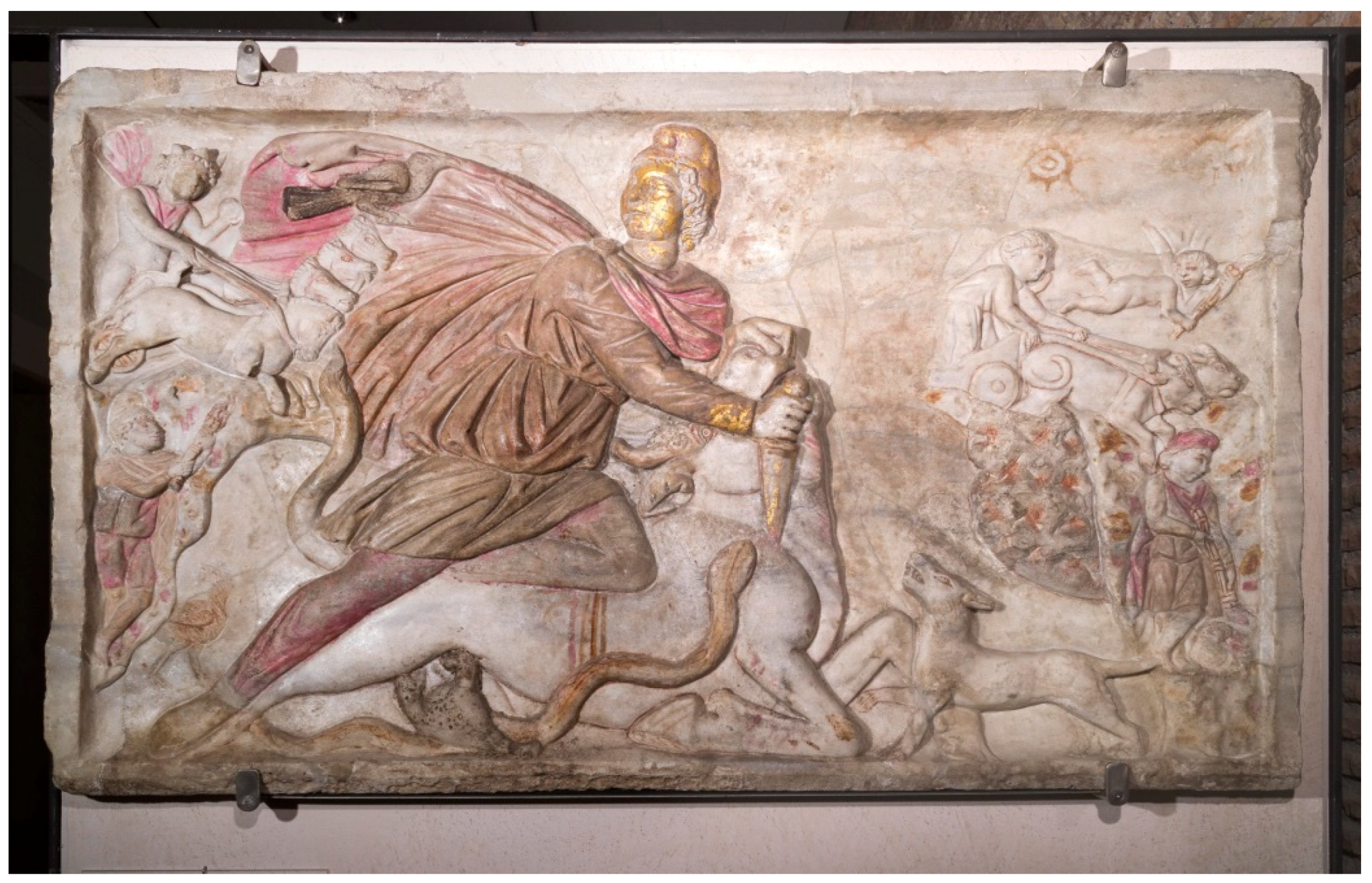

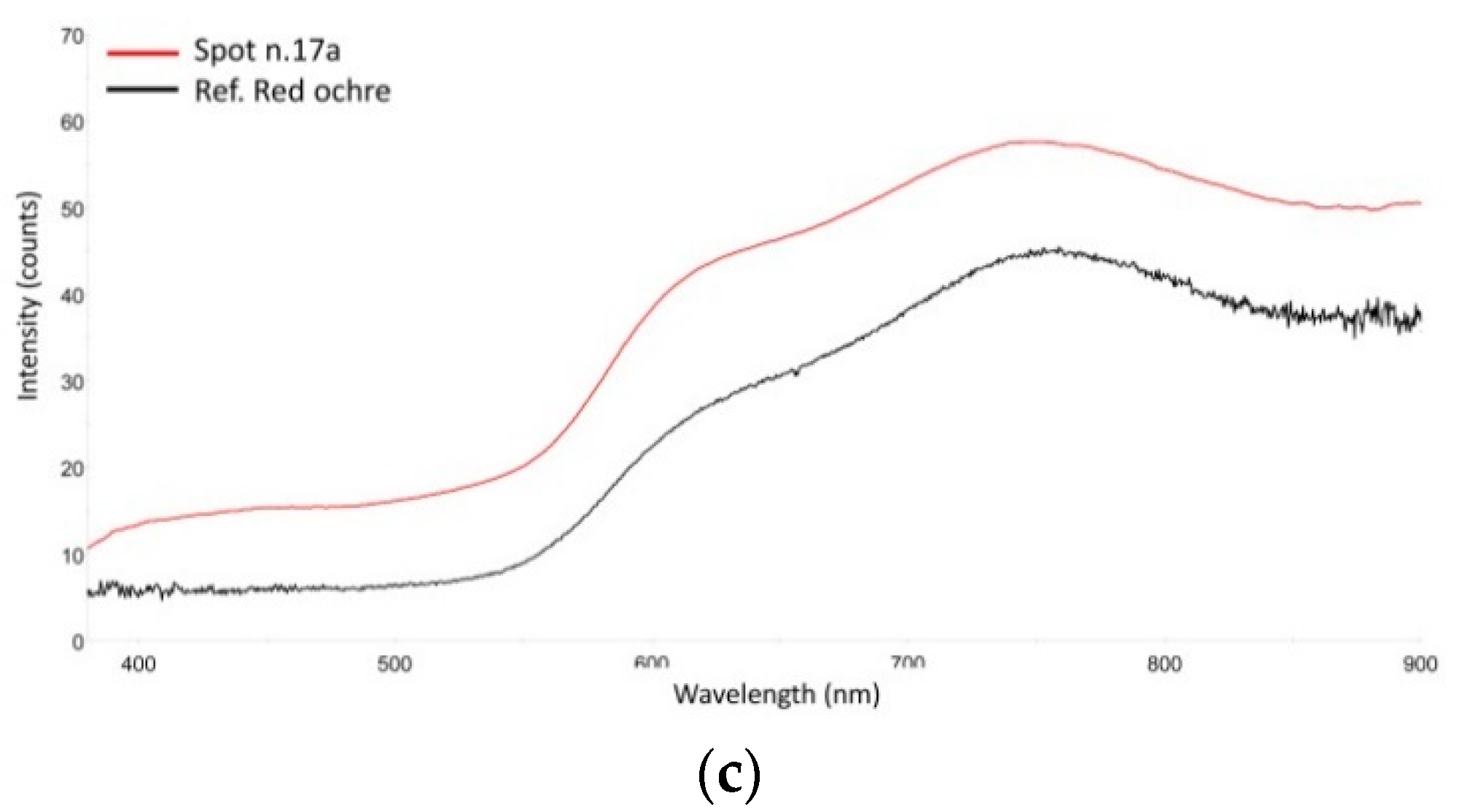
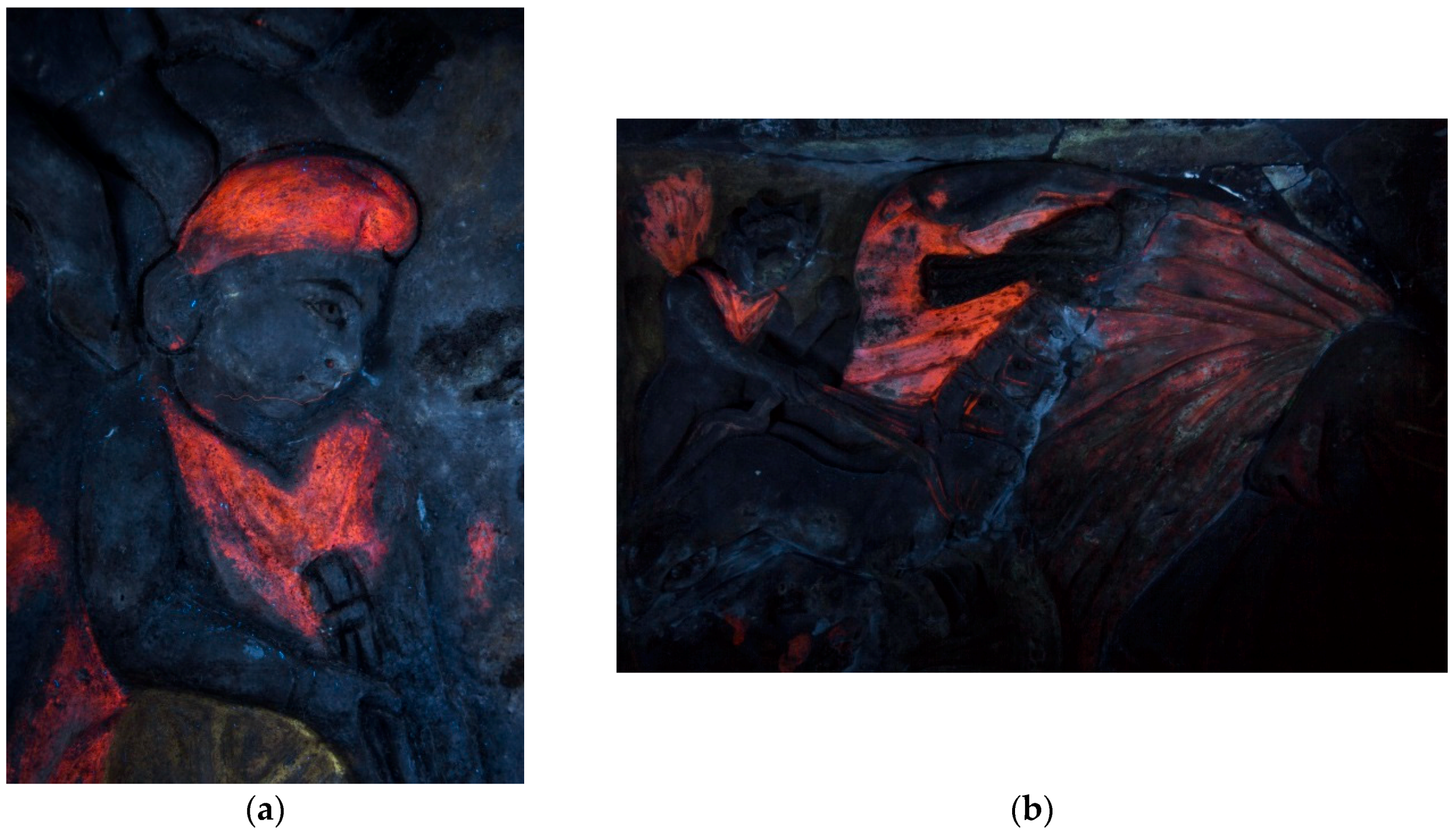
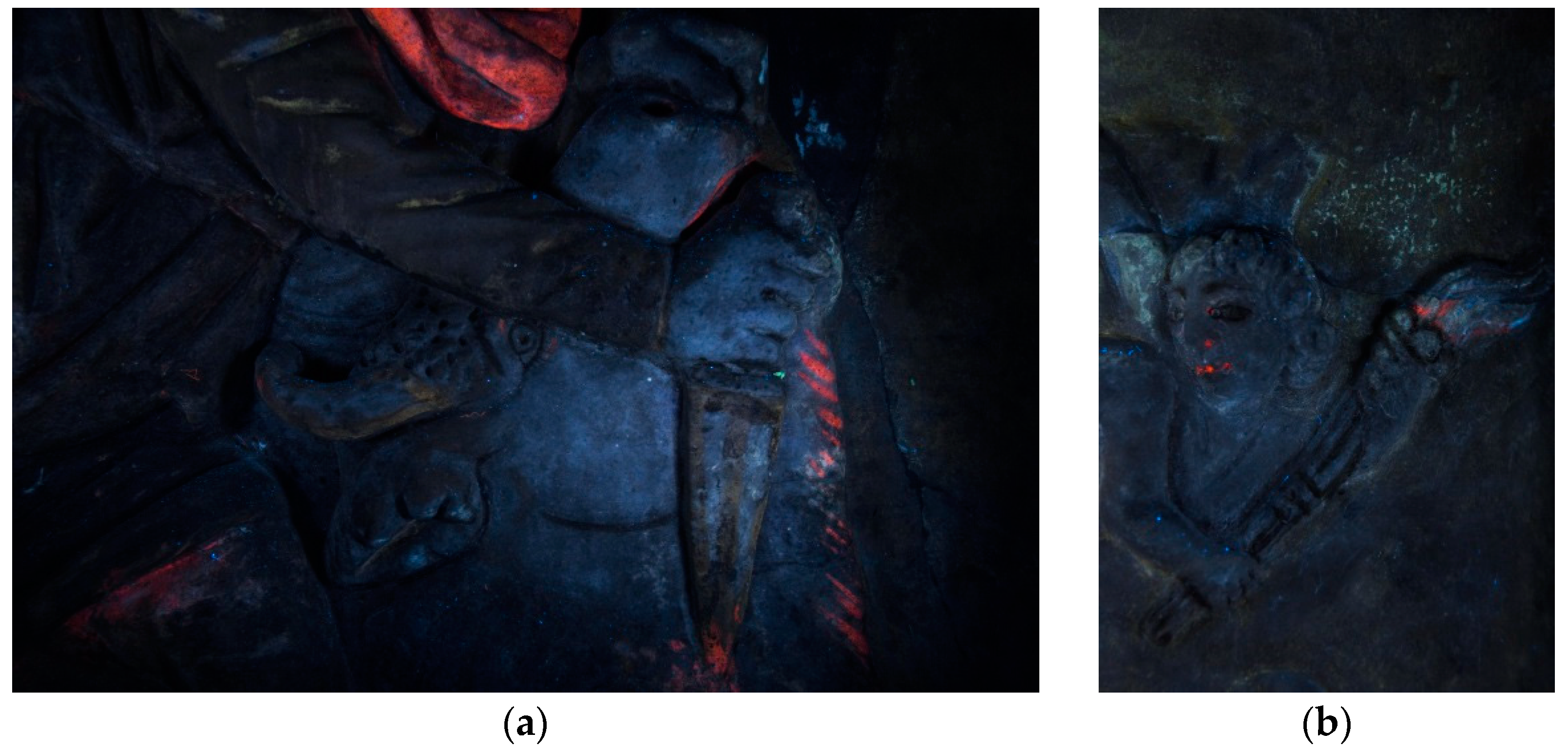
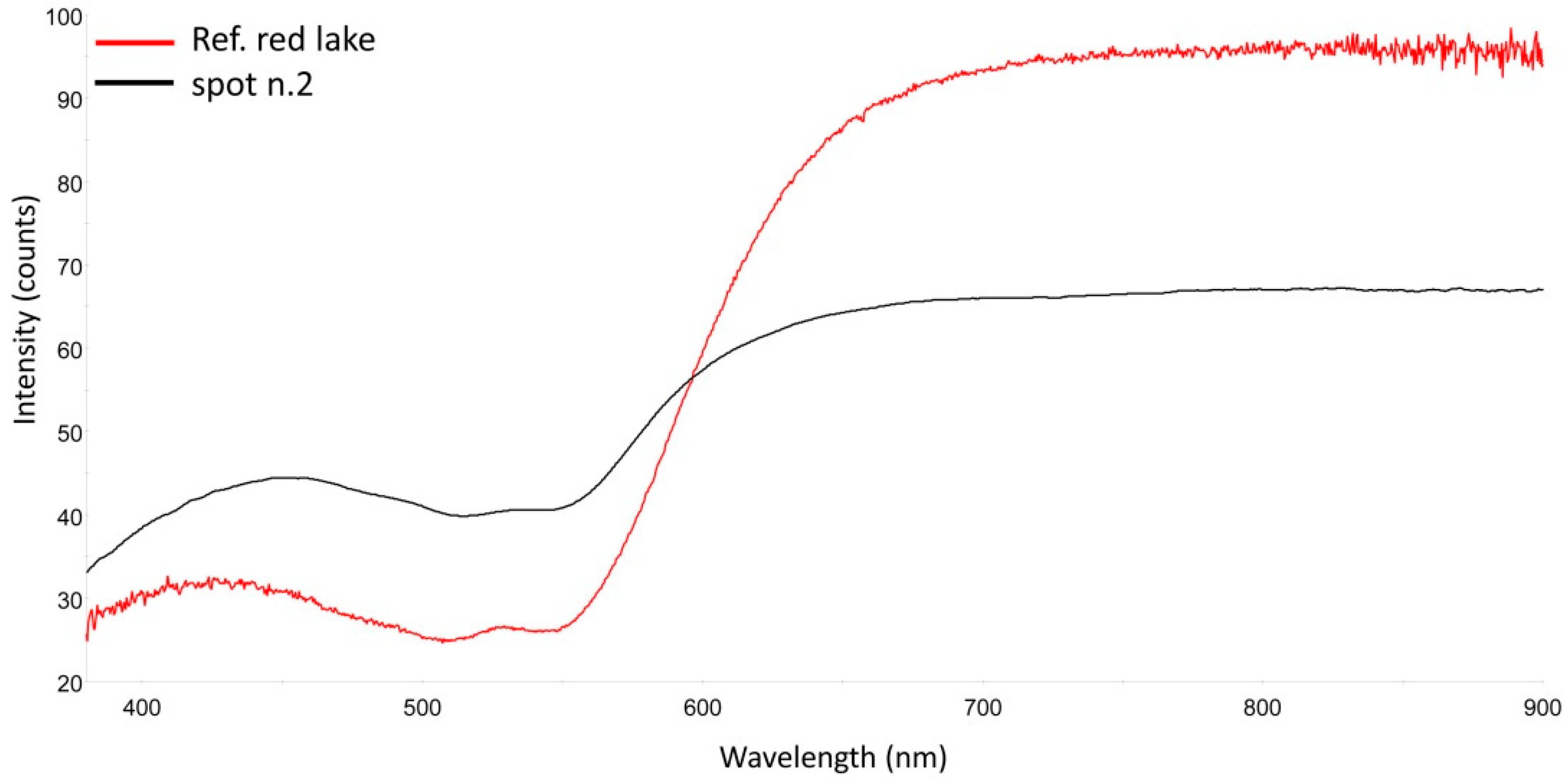
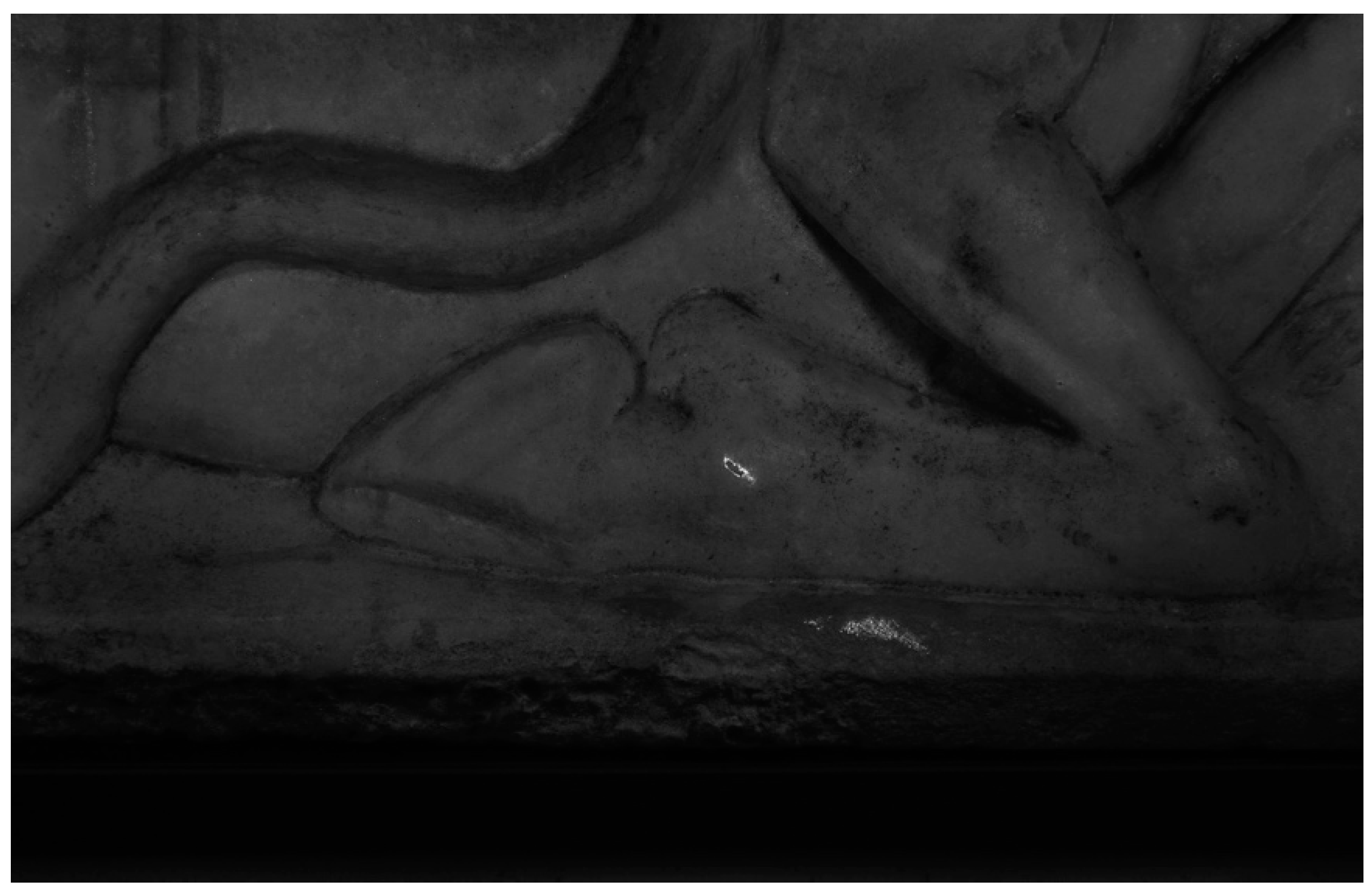
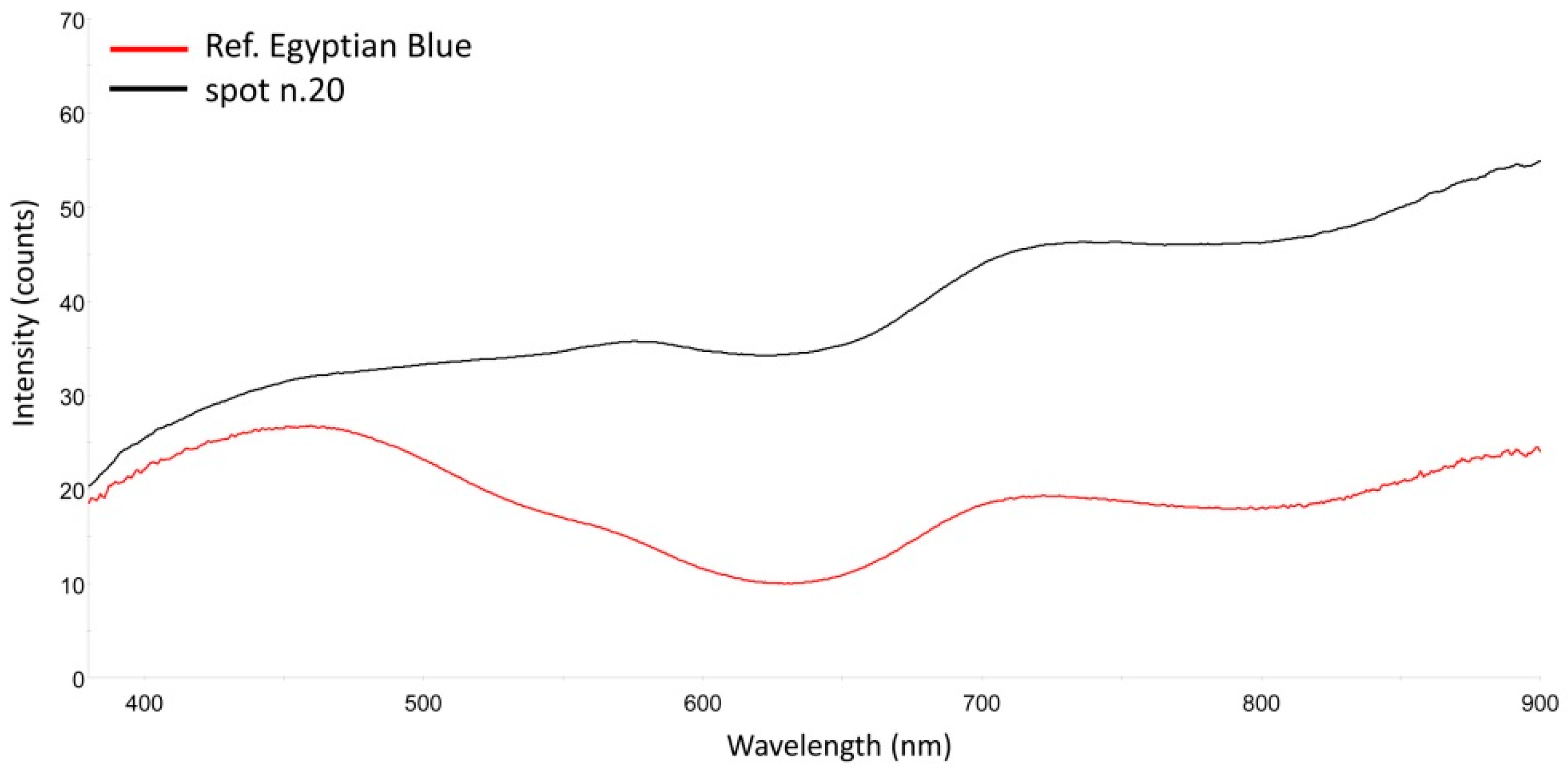
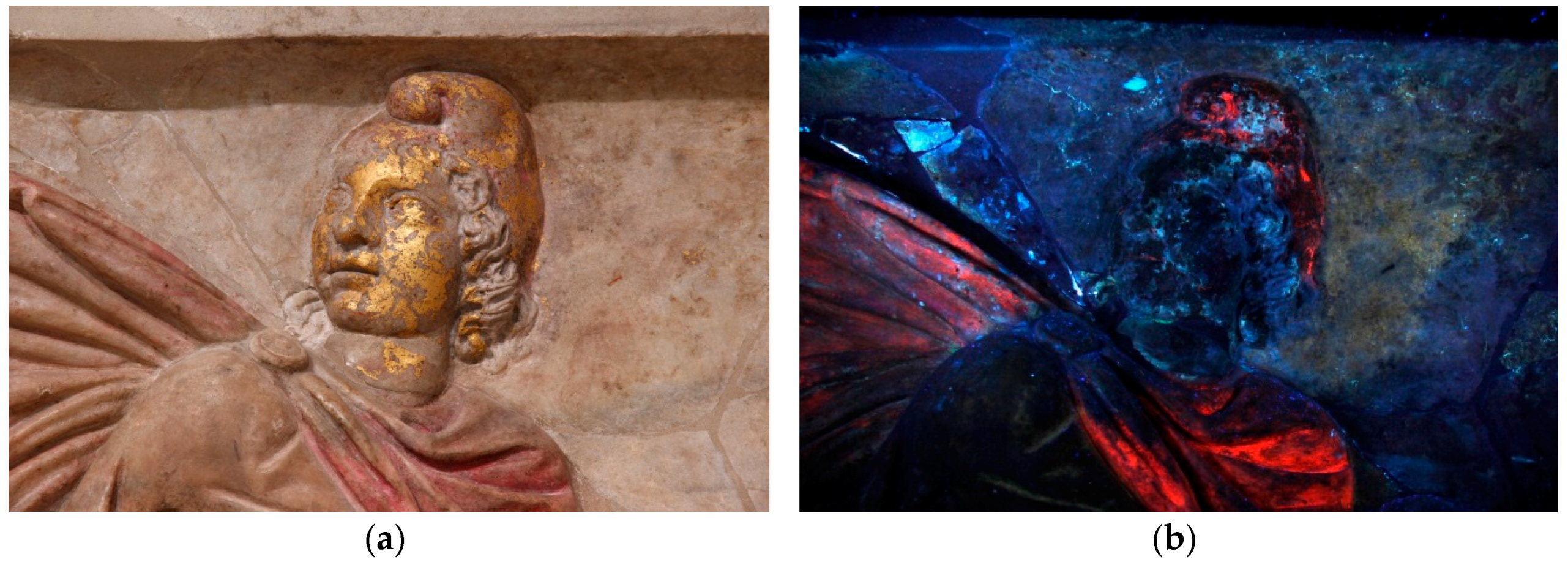
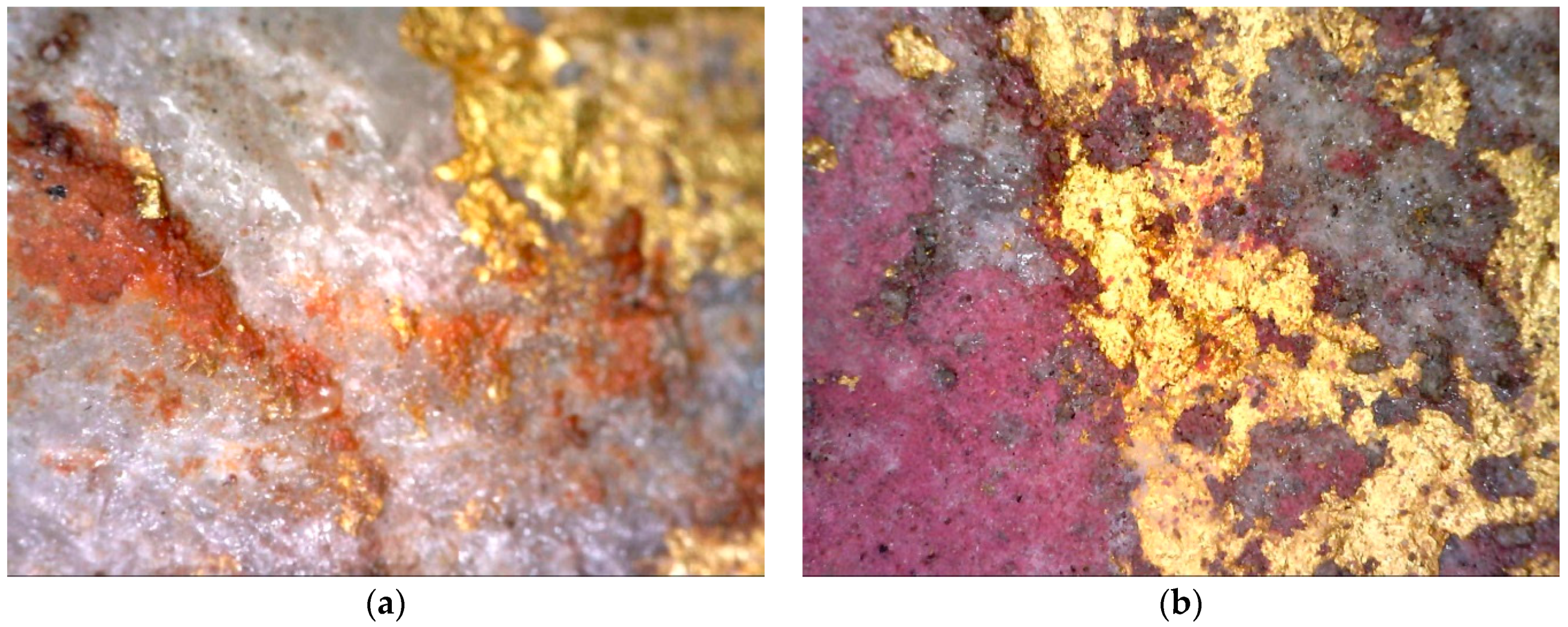
| Analytical Techniques Applied | Number of Acquisitions |
|---|---|
| Multispectral imaging: Visible reflected (400–700 nm) | 70 |
| Ultraviolet-induced luminescence (400–700 nm) | 70 |
| Visible-induced luminescence (800–1100 nm) | 70 |
| Optical microscopy | 70 |
| UV-ViS Fiber optics reflectance spectroscopy (FORS) (350–900 nm) | 30 |
| Portable X-ray fluorescence spectroscopy (p-XRF) | 30 |
© 2019 by the authors. Licensee MDPI, Basel, Switzerland. This article is an open access article distributed under the terms and conditions of the Creative Commons Attribution (CC BY) license (http://creativecommons.org/licenses/by/4.0/).
Share and Cite
Magrini, D.; Bracci, S.; Bartolozzi, G.; Iannaccone, R.; Lenzi, S.; Liverani, P. Revealing Mithras’ Color with the ICVBC Mobile Lab in the Museum. Heritage 2019, 2, 2160-2170. https://doi.org/10.3390/heritage2030130
Magrini D, Bracci S, Bartolozzi G, Iannaccone R, Lenzi S, Liverani P. Revealing Mithras’ Color with the ICVBC Mobile Lab in the Museum. Heritage. 2019; 2(3):2160-2170. https://doi.org/10.3390/heritage2030130
Chicago/Turabian StyleMagrini, Donata, Susanna Bracci, Giovanni Bartolozzi, Roberta Iannaccone, Sara Lenzi, and Paolo Liverani. 2019. "Revealing Mithras’ Color with the ICVBC Mobile Lab in the Museum" Heritage 2, no. 3: 2160-2170. https://doi.org/10.3390/heritage2030130
APA StyleMagrini, D., Bracci, S., Bartolozzi, G., Iannaccone, R., Lenzi, S., & Liverani, P. (2019). Revealing Mithras’ Color with the ICVBC Mobile Lab in the Museum. Heritage, 2(3), 2160-2170. https://doi.org/10.3390/heritage2030130






